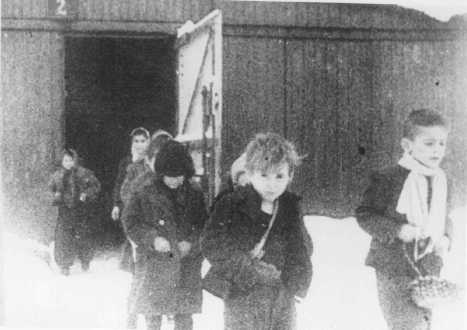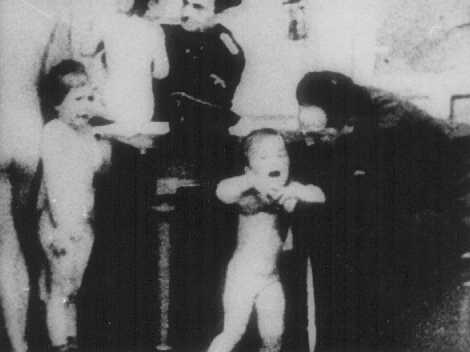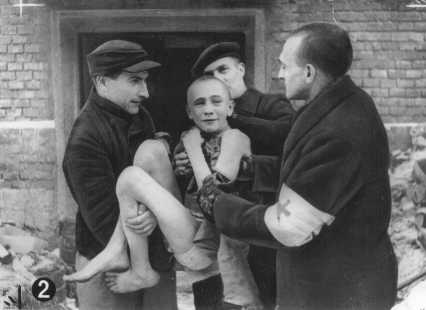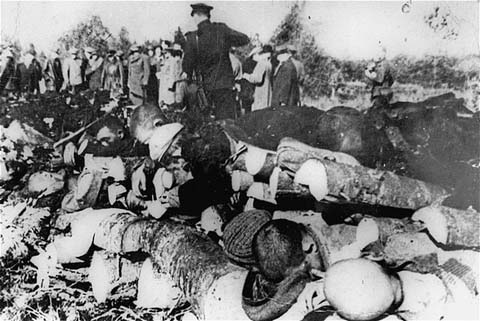A mother moments before being shot in the head by a German soldier in Ukraine while it has in his arms his daughter of approximately five or six years.
A grandmother with his small grandson coming to the selection of a German concentration camp. They will be dead in a few minutes.
Open mass grave in Proskuriv ( Ukraine ) 1941 or 1942. Like Dante´s hell.
A young mother in Lubny ( Ukraine ) with their children before be killed that same day , October 16, 1941.
It´s of impossible comprehension the anxiety that he had to feel with her girl sleeping in arms and waiting for the death. The look of the child reflects the suspicion towards the one who takes the photo. A German and therefore a killer.
Of course, there aren´t photos of inside the death chambers, but a survivor of the Sonderkommando ( Group of prisoners forced to withdraw the corpses and that after were murdered from time to time) survived and realized a few drawings that are exhibited in the Museum of the Combatants of the Ghettos, in Galilee, Israel.
In the room to undress. David Olère 1946.
In the gas camera. David Olère 1950
In the room of the stoves. David Olère. 1945
To observe that the body of the children was often placed on its mother or another adult to burn them.

Shortly after his release, child survivors of Auschwitz walk out of their barracks. Poland, after January 27, 1945.*
* Holocaust Encyclopedia ( United States Holacaust Memorial Museum )

Dr. Fritz Klein, a field doctor who conducted medical experiments on prisoners, stands among the corpses in a mass grave. Bergen-Belsen, Germany, after April 15, 1945.
- U.S. Holocaust Memorial Museum

German officers examine Polish children to determine if they qualify as "Aryans." Poland during the war.
- U.S. Holocaust Memorial Museum

Soon after liberation of the camp, first aid Soviet personnel brings one of the survivors, a malnourished child, in one of the camp huts. Auschwitz, Poland, after the January 27, 1945.
- La Documentation Francaise

Corpses of prisoners discovered by Soviet troops in the forced labor camp Klooga. The guards Nazis and Estonian collaborators had executed prisoners and the bodies were stacked for burning. Estonia, September 1944 ..
- Beit Lohamei Haghettaot
To observe that the body of the children was often placed on its mother or another adult to burn them.

Shortly after his release, child survivors of Auschwitz walk out of their barracks. Poland, after January 27, 1945.*
* Holocaust Encyclopedia ( United States Holacaust Memorial Museum )

Dr. Fritz Klein, a field doctor who conducted medical experiments on prisoners, stands among the corpses in a mass grave. Bergen-Belsen, Germany, after April 15, 1945.
- U.S. Holocaust Memorial Museum

German officers examine Polish children to determine if they qualify as "Aryans." Poland during the war.
- U.S. Holocaust Memorial Museum

Soon after liberation of the camp, first aid Soviet personnel brings one of the survivors, a malnourished child, in one of the camp huts. Auschwitz, Poland, after the January 27, 1945.
- La Documentation Francaise

Corpses of prisoners discovered by Soviet troops in the forced labor camp Klooga. The guards Nazis and Estonian collaborators had executed prisoners and the bodies were stacked for burning. Estonia, September 1944 ..
- Beit Lohamei Haghettaot









No comments:
Post a Comment